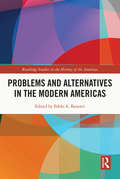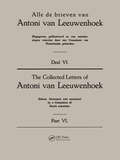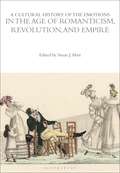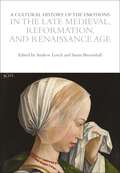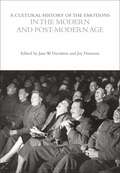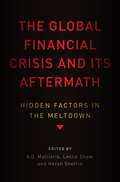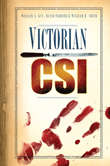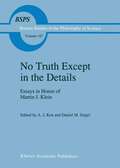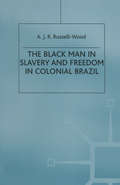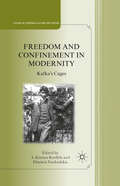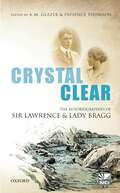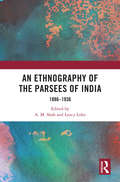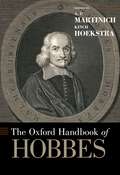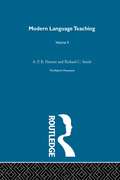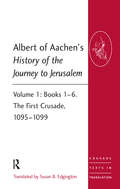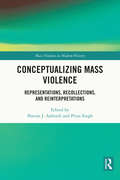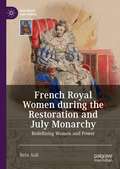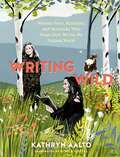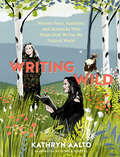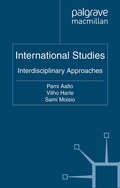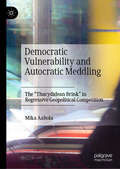- Table View
- List View
Problems and Alternatives in the Modern Americas
by Baisotti Pablo A.This volume explores several notable themes related to political processes in Latin America and offers insightful historical perspectives to understand national, regional, and global issues in the continent from the beginning of the 20th century to the present day. The collected essays focus on Latin American politics such as: political cycles, left-wing political parties, nationalism, progressivism, crime and resistance, violence, authoritarianism, and relationships with the United States, Venezuela, Chile, Ecuador, Brazil, Colombia, and Paraguay. The perspectives of the chapters presented an attempt to seek lines of continuity by highlighting traditional interpretations of new scenarios and refusing to impose a traditional and uncritical linear historical narrative. The fundamental objective of the volume is to provide a rational and critical political-historical explanation of Latin America since the early 20th century with the purpose, among others, of deepening understanding of the present.
Collected Letters Van Leeuwenhoek, Volume 6
by A Commission of Dutch scientists.This 6th volume in a 19-volume series contains 21 letters written by van Leeuwenhoek of the perod 1686-87. The contents of the letters published here, again show the great range of subjects that occupied Van Leeuwenhoek: from sugar candy, the shape and crystal structure of diamonds, the dissolution of silver crystals in aqua fortis to gold dust from Guinea dissolved in aqua regia and the dissolution and separation of gold, silver, and copper. Every volume in the Series contains the texts in the original Dutch and an English translation. The great range of subjects studied by Van Leeuwenhoek is reflected in these letters: instruments to measure water, pulmonary diseases; experiments relating to the solution of gold and silver; salt crystals and grains of sand; botanical work, such as duckweed and germination of orange pips; description on protozoa. blood, spermatozoa and health and hygiene, for example and harmfulness of tea and coffee and the benefits of cleaning teeth.
A Cultural History of the Emotions in the Age of Romanticism, Revolution, and Empire (The Cultural Histories Series)
by A Cultural History of The Emotions: In The Age of Romanticism, Revolution, and Empire: Volume 5Between 1780 and 1920, modern conceptions of emotion-conceptions still very much present in the 21st century-first took shape. This book traces that history, charting the changing meaning and experience of feelings in an era shaped by political and market revolutions, romanticism, empiricism, the rise of psychology and psychoanalysis. During this period, the word emotion itself gained currency, gradually supplanting older vocabularies and visions of feeling. Terms to describe feelings changed; so too did conceptions of emotions' proper role in politics, economics, and culture. Political upheavals turned a spotlight on the role of feeling in public life; in domestic life, sentimental bonds gained new importance, as families were transformed from productive units to emotional ones. From the halls of parliaments to the familial hearth, from the art museum to the theatre, from the pulpit to the concert hall, lively debates over feelings raged across the 19th century.
A Cultural History of the Emotions in the Late Medieval, Reformation, and Renaissance Age (The Cultural Histories Series)
by A Cultural History of The Emotions: In the Late Medieval, Reformation, and Renaissance Age: Volume 3The period 1300-1600 CE was one of intense and far-reaching emotional realignments in European culture. New desires and developments in politics, religion, philosophy, the arts and literature fundamentally changed emotional attitudes to history, creating the sense of a rupture from the immediate past. In this volatile context, cultural products of all kinds offered competing objects of love, hate, hope and fear. Art, music, dance and song provided new models of family affection, interpersonal intimacy, relationship with God, and gender and national identities. The public and private spaces of courts, cities and houses shaped the practices and rituals in which emotional lives were expressed and understood. Scientific and medical discoveries changed emotional relations to the cosmos, the natural world and the body. Both continuing traditions and new sources of cultural authority made emotions central to the concept of human nature, and involved them in every aspect of existence.
A Cultural History of the Emotions in the Modern and Post-Modern Age (The Cultural Histories Series)
by A Cultural History of The Emotions: In The Modern and Post-Modern AgeThe 20th century, with revolutionary and rapid developments in travel, communications and computerised technologies, offered new and seemingly limitless horizons which accompanied and amplified distinctive experiences of emotions. The birth of psychology and psychiatry revealed the importance of emotional life and that individuals could have control over their behaviour. Traditional religion was challenged and alternative forms of spiritualism emerged. Creative and performing arts continued to shape understandings and experiences of emotions, from realism to detachment, holistic to fragmented notions of self and society. The role of emotions in family life focused on how to deal with modern day freedom and anxiety. In the public sphere, people used emotion to oppress as well as liberate. Countering threats to national security, personal and cultural identity, a range of political motivated activities emerged embracing peace, humanitarian and environmental causes. This volume surveys the means by which modern experience shaped how, why and where emotions were expressed, monitored and controlled.
The Global Financial Crisis and Its Aftermath: Hidden Factors in the Meltdown
by A. G. Malliaris, Leslie Shaw and Hersh ShefrinIn The Global Financial Crisis, contributors argue that the complexity of the Global Financial Crisis challenges researchers to offer more comprehensive explanations by extending the scope and range of their traditional investigations. To achieve this, the volume views the financial crisis simultaneously through three different lenses---economic, psychological, and social values. Contributors offer a constructive methodology suitable for exploring financial crises. They recognize how current economic analysis did not prepare academic economists, business economists, traders, and regulators to anticipate economic and financial crises. So, they search more extensively within the broader discipline of economics for ideas related to crises but neglected perhaps because they were not mathematically rigorous. They affirm that the complexity of financial crises necessitates complementary research. Thus, to put the focal purpose of this book differently, they explore the Global Financial Crisis from three interconnected frameworks: the standards of orthodox economic analysis, Minskyan economics, and the role of ideas and values in economics. Values are the subject of both philosophy and psychology and can contribute to a better understanding of the Global Financial Crisis. Values, in general, have been relatively neglected by economists. This is not because there is doubt about their significance, but rather because welfare economics and collective choice still operate within the neoclassical paradigm. This volume argues that analyzing the value implications requires moving from the neoclassical framework to something that is broader and multidisciplinary.
Victorian CSI (History Press Ser.)
by William A Guy William Smith David FerrierThe first edition of William A. Guy's "Principles of Forensic Medicine" was published at the start of Victoria's reign; the final edition, from which these selections derive, was published towards the end, just a few years after the Whitechapel horrors had pushed the emerging science to the forefront of the public's consciousness. With this guide in hand, a detective could tell whether the victim had suffocated, drowned, been shot, stabbed, or struck by lightning, spontaneously combusted, frozen to death or expired due to starvation - or, as the guide warns, was not dead at all, but simply in a state of 'suspended animation'. Suggestions include examining the face of the deceased for an 'expression of angry resistance', a clear indication of murder, and studying the demeanour of the nearest and dearest in cases of suspected 'secret poisoning'. With original woodcuts, case studies and notes on identifying the corpse and walking the crime scene, "Victorian CSI" will fascinate lovers of crime fiction and of true crime alike.
No Truth Except in the Details: Essays in Honor of Martin J. Klein (Boston Studies in the Philosophy and History of Science #167)
by A. J. Kox and Daniel M. SiegelBeginning with a couple of essays dealing with the experimental and mathematical foundations of physics in the work of Henry Cavendish and Joseph Fourier, the volume goes on to consider the broad areas of investigation that constituted the central foci of the development of the physics discipline in the nineteenth century: electricity and magnetism, including especially the work of Michael Faraday, William Thomson, and James Clerk Maxwell; and thermodynamics and matter theory, including the theoretical work and legacy of Josiah Willard Gibbs, some experimental work relating to thermodynamics and kinetic theory of Heinrich Hertz, and the work of Felix Seyler-Hoppe on hemoglobin in the neighboring field of biophysics/biochemistry. Moving on to the beginning of the twentieth century, a set of three articles on Albert Einstein deal with his early career and various influences on his work. Finally, a set of historiographical issues important for the history of physics are discussed, and the chronological conclusion of the volume is an article on the Solvay Conference of 1933. For physicists interested in the history of their discipline, historians and philosophers of science, and graduate students in these and related disciplines.
Freedom and Confinement in Modernity: Kafka's Cages (Studies in European Culture and History)
by A. Kiarina Kordela & Dimitris VardoulakisKafka's literary universe is organized around constellations of imprisonment. Freedom and Confinement in Modernity proposes that imprisonment does not signify a tortured state of the individual in modernity. Rather, it provides a new reading of imprisonment suggesting it allows Kafka to perform a critique of a modernity instead.
Crystal Clear: The Autobiographies of Sir Lawrence and Lady Bragg
by A. M. Glazer and Patience ThomsonCrystal Clear takes you behind the scenes in the life of one of the most prominent scientists of the twentieth century, William Lawrence Bragg (WLB) - an innovative genius, who together with his father, William Henry Bragg (WHB) founded and developed a whole new branch of science, X-ray Crystallography. The main body of the text contains the hitherto unpublished autobiographies of both WLB and his wife, Alice. Alice Bragg was a public figure in her own right. She was Mayor of Cambridge and National Chairman of the Marriage Guidance Council among other roles. She and WLB were as different as chalk and cheese. Their autobiographies complement each other to give a rounded picture of the real personalities behind their public appearance. They write of their travels, their family life, their friends and their joys and sorrows. They write most of all about each other. Their younger daughter, Patience Thomson, provides anecdotes and vignettes, bringing her parents to life. She has also included extracts from previously unpublished letters and from articles which Alice Bragg wrote for National newspapers. The result is an unusual insight into the lives of two distinguished people. The two accounts reveal a fascinating interaction between these two characters, neither of whom could have achieved on this scale without the other. There is an underlying love story here which humanises and transforms. This is a unique book, adopting an original viewpoint, which will take the reader far beyond the scope of a normal biography.
An Ethnography of the Parsees of India: 1886–1936
by A. M. Shah and Lancy LoboThis volume explores a wide spectrum of Parsee culture and society derived through essays from the Journal of Anthropological Society of Bombay (1886–1936). This journal documents intensive scholarship on the Parsee community by eminent anthropologists, Indologists, orientalogists, historians, linguists, and administrators in the late 18th and early 19th centuries. Comprising 0.05% of India’s total population today, the Parsees (now spelled “Parsis”) have made significant contributions to modern India. Through contributions of Jivanji Jamshedji Modi, Bomanjee Byramjee Patell, and Rustamji Munshi, eminent Parsee scholars, the essays in this book discuss the social and cultural frameworks which constitute various key phases in the Parsee life nearly 100 years ago. They also focus on themes such as birth, childhood and initiation, marriage, and death. The volume also features works on Parsee folklore and oral literature. An important contribution to Parsi culture and living, this book will be of great interest to scholars and researchers of sociology, social anthropology, ethnography, cultural studies, history, and South Asia studies.
The Oxford Handbook of Hobbes (Oxford Handbooks)
by A. P. Martinich, Kinch HoekstraThe Oxford Handbook of Hobbes collects twenty-six newly commissioned, original chapters on the philosophy of the English thinker Thomas Hobbes (1588-1679). Best known today for his important influence on political philosophy, Hobbes was in fact a wide and deep thinker on a diverse range of issues. The chapters included in this Oxford Handbook cover the full range of Hobbes's thought--his philosophy of logic and language; his view of physics and scientific method; his ethics, political philosophy, and philosophy of law; and his views of religion, history, and literature. Several of the chapters overlap in fruitful ways, so that the reader can see the richness and depth of Hobbes's thought from a variety of perspectives. The contributors are experts on Hobbes from many countries, whose home disciplines include philosophy, political science, history, and literature. A substantial introduction places Hobbes's work, and contemporary scholarship on Hobbes, in a broad context.
Early Years of Reform (Logos Studies in Language and Linguistics)
by A. P. R. Howatt and Richard C. SmithThis volume forms part of a five volume set charting the progress of the nineteenth century movement, which was instrumental in establishing international guidelines for the teaching of modern languages. It was during this period that for the first time, co-operation between phoneticians and teachers culminated in the publication of works that were instrumental in establishing the 'applied linguistic' approach to language teaching in the twentieth century. For the first time, too, the new science of psychology influenced a scientific theory of second language acquisition. The Reform Movement attracted support across Europe, spurring the development of new professional associations and journals. In turn, the publication in these journals of reports of innovative practice contributed to a greater sense of autonomy and professionalism among modern language teachers, who had hitherto tended to live under the shadow of classical language teaching. The practical innovations and theoretical suggestions for the foreign language teaching, although rooted in the nineteenth century, still have relevance today.
Art, Global Maoism and the Chinese Cultural Revolution (Rethinking Art's Histories)
by A X00ED Jacopo Galimberti Noemi de Haro Garc Victoria H. F. ScottThis is the first book to explore the global influence of Maoism on modern and contemporary art. Featuring eighteen original essays written by established and emerging scholars from around the world, and illustrated with fascinating images not widely known in the west, the volume demonstrates the significance of visuality in understanding the protean nature of this powerful worldwide revolutionary movement. Contributions address regions as diverse as Singapore, Madrid, Lima and Maputo, moving beyond stereotypes and misconceptions of Mao Zedong Thought's influence on art to deliver a survey of the social and political contexts of this international phenomenon. At the same time, the book attends to the the similarities and differences between each case study. It demonstrates that the chameleonic appearances of global Maoism deserve a more prominent place in the art history of both the twentieth and twenty-first centuries.
Art, Global Maoism and the Chinese Cultural Revolution (Rethinking Art's Histories)
by A X00ED Jacopo Galimberti Noemi de Haro Garc Victoria H. F. ScottThis is the first book to explore the global influence of Maoism on modern and contemporary art. Featuring eighteen original essays written by established and emerging scholars from around the world, and illustrated with fascinating images not widely known in the west, the volume demonstrates the significance of visuality in understanding the protean nature of this powerful worldwide revolutionary movement. Contributions address regions as diverse as Singapore, Madrid, Lima and Maputo, moving beyond stereotypes and misconceptions of Mao Zedong Thought's influence on art to deliver a survey of the social and political contexts of this international phenomenon. At the same time, the book attends to the the similarities and differences between each case study. It demonstrates that the chameleonic appearances of global Maoism deserve a more prominent place in the art history of both the twentieth and twenty-first centuries.
Albert of Aachen's History of the Journey to Jerusalem: Volume 1: Books 1–6. The First Crusade, 1095–1099 (Crusade Texts in Translation)
by Albert Of AachenAlbert of Aachen’s History of the Journey to Jerusalem presents the story of the First Crusade (1095-1099) and the early history of the crusader states (1099-1119). Volume 1, The First Crusade, is a long and richly detailed account of events well known from the reports of participants, such as Fulcher of Chartres, Raymond of Aguilers and the anonymous author of the Gesta Francorum, but told from a strikingly different perspective. Albert did not go on crusade himself, but gathered reports and anecdotes from those who did, and wove them into narrative that foregrounds the activities of Peter the Hermit, Godfrey of Bouillon, Baldwin of Boulogne, and their followers. His History therefore offers a counter-balance, and sometimes a corrective, to the established view. Susan B. Edgington’s English translation has been widely praised, following its first publication in the Oxford Medieval Texts series, and is here presented with a new introduction and updated notes and bibliography.
Conceptualizing Mass Violence: Representations, Recollections, and Reinterpretations (Mass Violence in Modern History)
by Navras J. Aafreedi Priya SinghConceptualizing Mass Violence draws attention to the conspicuous inability to inhibit mass violence in myriads forms and considers the plausible reasons for doing so. Focusing on a postcolonial perspective, the volume seeks to popularize and institutionalize the study of mass violence in South Asia. The essays explore and deliberate upon the varied aspects of mass violence, namely revisionism, reconstruction, atrocities, trauma, memorialization and literature, the need for Holocaust education, and the criticality of dialogue and reconciliation. The language, content, and characteristics of mass violence/genocide explicitly reinforce its aggressive, transmuting, and multifaceted character and the consequent necessity to understand the same in a nuanced manner. The book is an attempt to do so as it takes episodes of mass violence for case study from all inhabited continents, from the twentieth century to the present. The volume studies ‘consciously enforced mass violence’ through an interdisciplinary approach and suggests that dialogue aimed at reconciliation is perhaps the singular agency via which a solution could be achieved from mass violence in the global context. The volume is essential reading for postgraduate students and scholars from the interdisciplinary fields of Holocaust and Genocide Studies, History, Political Science, Sociology, World History, Human Rights, and Global Studies.
Conceptualizing Mass Violence: Representations, Recollections, and Reinterpretations (Mass Violence in Modern History)
by Navras J. Aafreedi Priya SinghConceptualizing Mass Violence draws attention to the conspicuous inability to inhibit mass violence in myriads forms and considers the plausible reasons for doing so. Focusing on a postcolonial perspective, the volume seeks to popularize and institutionalize the study of mass violence in South Asia. The essays explore and deliberate upon the varied aspects of mass violence, namely revisionism, reconstruction, atrocities, trauma, memorialization and literature, the need for Holocaust education, and the criticality of dialogue and reconciliation. The language, content, and characteristics of mass violence/genocide explicitly reinforce its aggressive, transmuting, and multifaceted character and the consequent necessity to understand the same in a nuanced manner. The book is an attempt to do so as it takes episodes of mass violence for case study from all inhabited continents, from the twentieth century to the present. The volume studies ‘consciously enforced mass violence’ through an interdisciplinary approach and suggests that dialogue aimed at reconciliation is perhaps the singular agency via which a solution could be achieved from mass violence in the global context. The volume is essential reading for postgraduate students and scholars from the interdisciplinary fields of Holocaust and Genocide Studies, History, Political Science, Sociology, World History, Human Rights, and Global Studies.
French Royal Women during the Restoration and July Monarchy: Redefining Women and Power (Queenship and Power)
by Heta AaliThis book examines public discussions around France's four most prominent royal women during the first and second Restoration and July Monarchy: the duchesse d’Angoulême, the duchesse de Berry, Queen of the French Marie-Amélie, and Adélaïde d’Orléans. These were the most powerful women of the last decades of the French monarchy, but the new roles women were assigned in post-revolutionary France did not permit them to openly exercise political influence. This book explores continuities and variations in narratives of royal legitimacy, and how historians, authors, and politicians used national history - particularly medieval and early modern history - to either legitimize or undermine the French monarchy, and to define women's social and political roles.
Writing Wild: Women Poets, Ramblers, And Mavericks Who Shape How We See The Natural World
by Kathryn AaltoWriting Wild: Women Poets, Ramblers, and Mavericks Who Shape How We See the Natural World
by Kathryn AaltoWriting Wild, by New York Times-bestselling author Kathryn Aalto, explores the lasting impact of 25 women writers whose pens have left an indelible mark on the world of nature writing.
International Studies: Interdisciplinary Approaches (Palgrave Studies in International Relations)
by Pami Aalto Vilho Harle Sami MoisioPresenting International Studies as a wide, plural and inherently interdisciplinary field of research, this book shows its links with philosophy, peace research, history, geography, globalization studies, international political economy, political psychology, sociology and social theory, linguistics, strategic or war studies and anthropology.
Democratic Vulnerability and Autocratic Meddling: The "Thucydidean Brink" in Regressive Geopolitical Competition
by Mika AaltolaThis book investigates complex regressive dynamics in contemporary Western democracies. They include not only severe polarization in domestic politics, but also efforts by external autocratic powers to co-opt the increasingly digitalized political processes in the West. The discussion on democratic vulnerability and regression has rarely been historically and theoretically reflective. The aim is to fill this relative void by drawing on classical sources to inform about the political anxieties and agitations of our present time as the Western world moves towards new critical elections. The key concept of the analysis, a Thucydidean brink, refers to a critical point where the attraction felt towards an outside geopolitical competitor becomes stronger than the political affinity felt towards one’s domestic political opponent. As political polarization, societal decomposition and the collusive tendencies grow in strength, political factions and political candidates in western societies can be(come) drawn to autocratic actors. Perhaps most alarmingly, the resulting nexus between democracies and autocracies can further intensify mutual regression and form downwards-sloping spirals that are not ultimately under any strategic control. This book draws from the experiences of recent elections in major Western democracies to illustrate the widening and deepening underlying regressive tendency.
Archaeology
by Gaynor AaltonenThroughout the ages, people have been fascinated by other people - who are they, what do they do, how do they live? Archaeology seeks to answer those questions about the history of mankind by analysing the remains of past cultures.Covering the complete duration of human history and spanning the entire globe, Archaeology: Discovering the World's Secrets volume provides the perfect introduction to the science of the past. From the Napoleonic expeditions to uncover the Rosetta stone in Egypt to the forgotten Anasazi empire of the American southwest, Gaynor Aaltonen explores the various techniques used by archaeologists and how they have changed over time to the recent embrace of the latest technologies and what this means for our understanding of the past.
